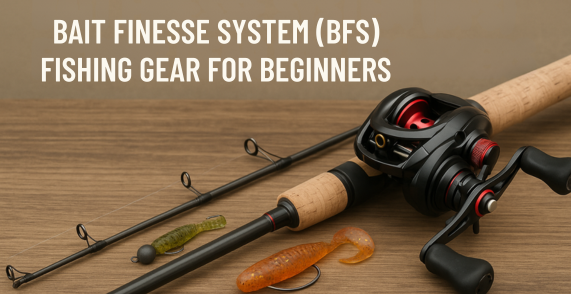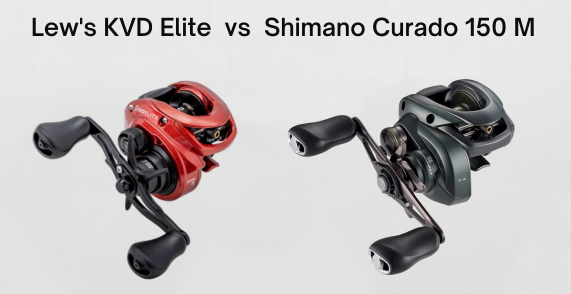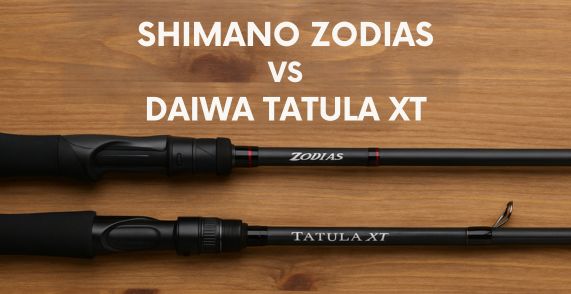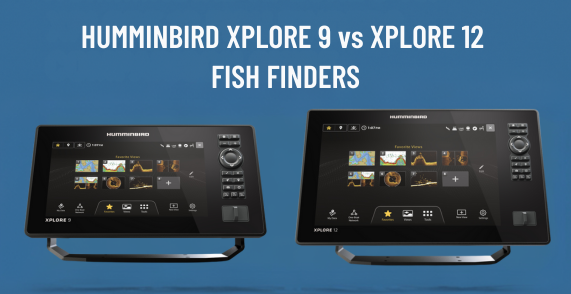In This Post
- 1 Key Takeaways
- 2 Why BFS Makes Sense for New Anglers in Pressured Waters
- 3 BFS vs. Spinning Reels: The Precision Advantage
- 4 Essential BFS Rod Features That Matter
- 5 BFS Reel Technology: Shallow Spools and Magnetic Brakes
- 6 Line Selection Strategy for BFS Success
- 7 Mastering the BFS Casting Technique
- 8 Verified Budget-Friendly Starter Combos
- 9 BFS Opens Precision Fishing Opportunities in Tight Quarters
Key Takeaways
- BFS gear provides precision casting control with ultra-light lures (typically 1/32 to 1/4 ounce), making it ideal for pressured waters where fish spook easily from traditional presentations.
- Beginner-friendly BFS combos can often be found starting under $150 and offer superior accuracy compared to spinning reels, with faster cast turnaround times for working tight cover effectively.
- Shallow spools and magnetic braking systems are the key technologies that allow BFS reels to cast impossibly light lures that would backlash on regular baitcasters.
- Rod loading technique is a key element in creating smooth power transfer – mastering this casting motion can significantly improve casting success for BFS anglers.
- Line selection strategy can make or break your success – braid-to-leader combinations offer the perfect balance of casting distance and stealth presentations.
Bait Finesse System fishing represents a game-changing approach for beginners who want to master precision angling in today’s heavily pressured waters. This specialized technique originated in Japan specifically to solve the problem of catching wary fish that ignore standard lure presentations.
Why BFS Makes Sense for New Anglers in Pressured Waters
Modern fishing waters face unprecedented pressure from countless anglers, creating a challenging environment where fish become increasingly selective and skittish.
BFS fishing gear offers a strategic solution by allowing anglers to target fish with ultra-light line and tiny lures on baitcasting equipment – a combination previously reserved for spinning setups.
The core advantage lies in BFS’s ability to present small packages to bass without requiring a direct approach.
BFS setups enable longer casts with ultra-light lures, often 1/16-ounce or smaller, giving anglers the stealth factor needed in clear water or heavily fished locations.
BFS can be particularly effective when fish are not actively feeding or in situations where traditional techniques fail.
The system allows downsized, micro versions of familiar baits, simplifying the entry point for beginners who can immediately apply techniques they already understand with smaller, more finesse-oriented presentations.
BFS vs. Spinning Reels: The Precision Advantage
While spinning reels dominate the ultralight fishing market, BFS systems provide distinct advantages that become apparent once anglers master the technique.
The comparison reveals why serious finesse anglers often abandon spinning gear entirely after experiencing BFS capabilities.
Superior Accuracy for Tight Spots
BFS casting offers exceptional accuracy, often exceeding that of spinning reels, particularly in tight spots, once the technique is mastered. The ability to feather the spool with thumb control provides an unmatched level of trajectory and speed management.
Anglers can place lures exactly where needed – under docks, next to logs, or into small pockets of cover – with single-handed precision casts that would be impossible with spinning tackle.
Better Line Management and Control
BFS systems significantly reduce line twist issues common with spinning reels due to their direct spool control design. The design allows for much faster cast turnaround time, enabling thorough and efficient coverage of structure without the bail management limitations that slow down spinning reel presentations.
Faster Cast Turnaround Time
The efficiency advantage becomes clear when working specific pieces of structure. BFS allows rapid-fire casting to multiple target zones without the mechanical delays associated with spinning reel operation.
This speed translates directly into more presentations per hour and increased fish contact opportunities in prime feeding windows.
Essential BFS Rod Features That Matter
BFS rods represent a radical departure from conventional baitcasting rod design, engineered specifically to load and cast ultra-light lures with precision. Understanding these design elements helps beginners select gear that will perform reliably from day one.
Reflexive Tips with Strong Backbones
The defining characteristic of BFS rods is their soft, whippy tips that load easily under light lure weights, combined with fast or extra-fast actions for accurate casting.
This forgiving tip section prevents fish from throwing hooks during fights while maintaining the backbone needed for control in heavy cover situations.
Power ratings typically range from ultra-light to light, with some medium-light options for versatility. The key is balancing sensitivity for bite detection with enough power to move fish away from structure before the light line breaks.
Lightweight Guide Design for Distance
Many BFS rods feature an increased number of guides compared to standard rods, aiding both casting distance and accuracy. These guides are typically small, lightweight ceramic designs that reduce friction during the cast while providing even line distribution along the blank.
The handle design is compact and ergonomic, with short rear grips and minimalist foregrips that allow direct feel of the blank. This design enables anglers to feel every slight “tick” of a bite, even with the lightest presentations.
BFS Reel Technology: Shallow Spools and Magnetic Brakes
BFS reels are the technological heart of the system, completely re-engineered to address the fundamental problem of spool inertia that prevents regular baitcasters from casting ultra-light lures effectively.
Shallow Spools Reduce Start-up Inertia
The most critical component is the ultralight, shallow spool design.
Traditional baitcasting spools are heavy and require significant force to begin rotating. BFS spools are designed to be lightweight, often weighing less than 10 grams, with some ultra-light models reaching weights as low as 3.7 grams, creating minimal inertia that can be started with minimal energy.
These spools are often heavily ported or “wiffled” to further reduce weight and feature minimal tolerance between spool and frame to prevent light lines from getting wedged.
This engineering allows lures weighing as little as 1/32 ounce to be cast accurately and smoothly.
Advanced Magnetic Braking Systems
Managing high rotational speeds requires sophisticated braking systems far more refined than conventional baitcasters.
The most effective systems, like Daiwa Air Brake and Shimano FTB (Finesse Tuned Brake), use dynamic mechanisms that apply more braking force at the beginning when the spool spins fastest, then reduce it as speed decreases.
This dynamic control prevents backlashes while maximizing casting distance – crucial for beginners who fear the infamous “bird’s nest” that can occur with improper technique or settings.
Fast Gear Ratios with Smaller IPT
BFS reels feature high gear ratios of 6.3:1 or higher for quick line retrieval, essential for working fast-moving baits and maintaining control over fighting fish on light line.
High-performance ball bearings, including micro-bearings and ceramic ball options, contribute to smoother operation and easier startup when casting ultra-light lures, especially those under 2.5 grams.
Line Selection Strategy for BFS Success
Line choice directly impacts casting distance, sensitivity, and fish-landing success. Each line type offers distinct advantages, and understanding these trade-offs helps beginners make informed decisions for different fishing scenarios.
1. Braid-to-Leader Combinations for Versatility
The most popular and effective approach combines braided mainline with fluorocarbon leader sections. This hybrid setup offers the best of both worlds: long-casting sensitivity of braid with the invisibility and abrasion resistance of fluorocarbon where it matters most.
A common and effective setup combines 8-10 pound braid mainline with 4-6 pound fluorocarbon leaders. While eight-strand braid is often preferred for its rounder profile and reduced digging, four-strand braids can offer greater abrasion resistance.
2. Fluorocarbon for Invisible Presentations
Fluorocarbon sinks, offers low stretch, and remains nearly invisible underwater – ideal for bottom-contact baits and stealthy presentations in clear water. Its abrasion resistance proves beneficial when fishing around rocky or woody cover where light lines face constant threat of breakage.
3. Monofilament for Shock Absorption
Monofilament also provides stretch that can benefit fast-action rod setups, offering shock-absorbing effects and is generally the most affordable option. It’s generally the most forgiving option for beginners learning proper technique and drag management.
Mastering the BFS Casting Technique
BFS casting differs fundamentally from traditional baitcasting, emphasizing smooth rod loading rather than power-based casting motions. Mastering this technique separates successful BFS anglers from those who struggle with constant backlashes.
Rod Loading Creates Smooth Power Transfer
The key technique involves moving the rod and lure away from the target first, then using the rod’s flex to propel the lure forward smoothly. This “loading up” action creates a wider power arc and allows the rod to perform most of the casting work rather than relying on angler-generated force.
The process starts with the lure wound close to the rod tip, rod pointing toward the target, then loading the rod by moving away from the target direction before executing smooth, controlled forward motion with optimal release timing for accuracy.
Thumb Control for Soft Lure Entries
Unlike spinning reels where line releases with finger control, BFS systems allow thumb pressure on the spool to control line speed throughout the cast.
This tactile control represents the system’s greatest advantage for precision presentations.
By applying slight thumb pressure just before the lure lands, anglers can slow the bait down for soft, stealthy water entry – critical for avoiding spooking in shallow or clear conditions.
Side casts are easier to master initially and provide flatter trajectories for better lure speed control.
Verified Budget-Friendly Starter Combos
The barrier to BFS entry has dropped significantly due to high-quality affordable gear from Chinese Domestic Market manufacturers.
These entry-level combinations provide reliable performance while learning proper techniques without major financial investment.
1. KastKing Zephyr BFS with Budget Rod Options
The KastKing Zephyr BFS reel (around $60) pairs excellently with budget rod options for total setups under $100. This reel offers reliable performance and smooth operation while learning BFS fundamentals.
When paired with quality entry rods like the Harding Magic L, it creates a capable system for lures in the 2-6 gram range.
2. Shimano SLX BFS Entry-Level Setups
The Shimano SLX BFS (pricing varies by retailer) represents a significant step up in performance, offering premium braking systems and refined user experience.
When combined with quality rods in the $60-80 range, total investment remains reasonable while providing noticeably improved casting performance and durability.
3. Alternative CDM Combos Under $150
Ultra-budget options include the Ace Hawk CU Double rod with Soloking Acura reel combination (pricing varies by retailer).
The rod often includes two tips (ultra-light and light) for versatility, while the reel provides smooth operation that rivals more expensive options from previous generations.
BFS Opens Precision Fishing Opportunities in Tight Quarters
BFS fishing represents more than just another technique – it’s a strategic approach that opens previously inaccessible angling opportunities.
The system particularly shines in clear water situations, heavily fished waters, and when targeting inactive fish that ignore larger presentations.
Effective techniques include drop shot rigs, Ned rigs, and wacky rigs that excel at enticing reluctant fish.
Damiki rigging using small jigheads with soft plastic baits proves especially effective for bass in cold water or high-pressure situations where traditional approaches fail.
The learning curve requires patience and practice, but rewards include enhanced casting accuracy, improved sensitivity, and access to fish that completely ignore conventional presentations.
Starting with heavier practice lures helps develop proper technique before progressing to ultralight options that demand precision.
BFS transforms challenging fishing scenarios into opportunities for consistent success through superior presentation control and stealth capabilities that conventional tackle simply cannot match.






